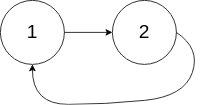Welcome to Subscribe On Youtube
141. Linked List Cycle
Description
Given head, the head of a linked list, determine if the linked list has a cycle in it.
There is a cycle in a linked list if there is some node in the list that can be reached again by continuously following the next pointer. Internally, pos is used to denote the index of the node that tail's next pointer is connected to. Note that pos is not passed as a parameter.
Return true if there is a cycle in the linked list. Otherwise, return false.
Example 1:

Input: head = [3,2,0,-4], pos = 1 Output: true Explanation: There is a cycle in the linked list, where the tail connects to the 1st node (0-indexed).
Example 2:

Input: head = [1,2], pos = 0 Output: true Explanation: There is a cycle in the linked list, where the tail connects to the 0th node.
Example 3:

Input: head = [1], pos = -1 Output: false Explanation: There is no cycle in the linked list.
Constraints:
- The number of the nodes in the list is in the range
[0, 104]. -105 <= Node.val <= 105posis-1or a valid index in the linked-list.
Follow up: Can you solve it using O(1) (i.e. constant) memory?
Solutions
Two pointers, a slow pointer that walks one step at a time and a fast pointer that walks two steps at a time. If there is a ring in the linked list, the two pointers will definitely meet at the same position eventually.
Or, use a set for duplicate check.
-
/** * Definition for singly-linked list. * class ListNode { * int val; * ListNode next; * ListNode(int x) { * val = x; * next = null; * } * } */ public class Solution { public boolean hasCycle(ListNode head) { ListNode slow = head; ListNode fast = head; while (fast != null && fast.next != null) { slow = slow.next; fast = fast.next.next; if (slow == fast) { return true; } } return false; } } -
/** * Definition for singly-linked list. * struct ListNode { * int val; * ListNode *next; * ListNode(int x) : val(x), next(NULL) {} * }; */ class Solution { public: bool hasCycle(ListNode* head) { ListNode* slow = head; ListNode* fast = head; while (fast && fast->next) { slow = slow->next; fast = fast->next->next; if (slow == fast) { return true; } } return false; } }; -
# Definition for singly-linked list. # class ListNode: # def __init__(self, x): # self.val = x # self.next = None class Solution: def hasCycle(self, head: ListNode) -> bool: slow = fast = head while fast and fast.next: slow, fast = slow.next, fast.next.next if slow == fast: return True return False -
/** * Definition for singly-linked list. * type ListNode struct { * Val int * Next *ListNode * } */ func hasCycle(head *ListNode) bool { slow, fast := head, head for fast != nil && fast.Next != nil { slow, fast = slow.Next, fast.Next.Next if slow == fast { return true } } return false } -
/** * Definition for singly-linked list. * class ListNode { * val: number * next: ListNode | null * constructor(val?: number, next?: ListNode | null) { * this.val = (val===undefined ? 0 : val) * this.next = (next===undefined ? null : next) * } * } */ function hasCycle(head: ListNode | null): boolean { let slow = head; let fast = head; while (fast !== null && fast.next !== null) { slow = slow.next; fast = fast.next.next; if (slow === fast) { return true; } } return false; } -
/** * Definition for singly-linked list. * function ListNode(val) { * this.val = val; * this.next = null; * } */ /** * @param {ListNode} head * @return {boolean} */ var hasCycle = function (head) { let slow = head; let fast = head; while (fast && fast.next) { slow = slow.next; fast = fast.next.next; if (slow === fast) { return true; } } return false; }; -
/** * Definition for singly-linked list. * public class ListNode { * public int val; * public ListNode next; * public ListNode(int x) { * val = x; * next = null; * } * } */ public class Solution { public bool HasCycle(ListNode head) { var fast = head; var slow = head; while (fast != null && fast.next != null) { fast = fast.next.next; slow = slow.next; if (fast == slow) { return true; } } return false; } }